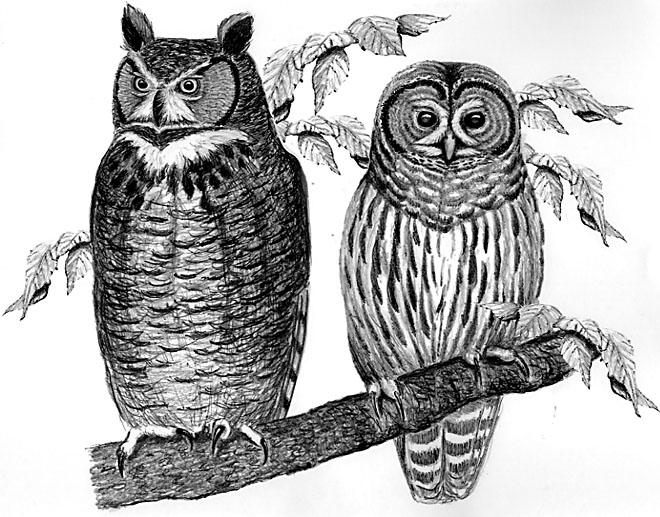
Dear Bird Folks,
My eight-year-old niece visited me recently, and one night we heard an owl calling in our yard. She asked me if it was a “hoot owl.” That got me wondering, do any owls actually say, “hoot”? I’ve never heard one enunciate the “t” at the end of “hoot.” Also, what types of owls are there on the Cape this time of year?
– Mandy, Eastham, MA
This one’s easy, Mandy,
Many of the notes I’ve received lately have contained some rather difficult questions. Instead of spending my free time watching Three Stooges reruns, I’ve actually had to research information and I hate that. But your question is the kind I like – nice and easy. The reason you never hear owls enunciate the “t” when they hoot is because they don’t have teeth. They need to push their tongue against their teeth in order to form the letter. Go ahead, try it. It can’t be done. That’s why you never hear an owl say the word “toast” or “turpentine.” They also don’t play tic-tac-toe. If they can’t say it, they can’t play it.
Some people may be surprised to learn that of the twelve different species of owls we regularly see in eastern North America, only a few of them do any kind of hooting, or hooing, if you prefer. The owls that don’t hoot make a whole assortment of other strange sounds including toots, coos, whinnies, hisses, and barks. Yes, barks. Apparently some owls decided that hooting made them sound like sissies, so they decided to bark instead. Yeah, I can see that.
By far, the most common nighttime hooter in these parts is the Great Horned Owl. The books say that great-horns are most often heard during late winter, but I find that these birds are yapaholics. Just about anytime I get up in the middle of the night to…you know…I hear great-horns calling. Based on their abundance and chattiness, I’m pretty sure that the owl you heard that night was a Great Horned Owl. A few years ago I would have guaranteed that your bird was a great-horned, but things have changed. Recently a new hooting owl has moved onto Cape Cod and suddenly there is competition for the title of late night hooting king.
The range map on the most recent Peterson Field Guide to Eastern Birds shows that Barred Owls are found throughout the entire eastern half of the United States, except for ol’ Cape Cod that is. For some reason, perhaps due to our lack of large trees, Barred Owls have avoided this part of the world. Well, you owl freaks out there will be happy to learn that the Cape’s Barred Owl-less days have come to an end. In the past year or so, not only has this owl started visiting our area, but it has begun breeding here, too. Though they are not nearly as common as the great-horns, they too are chatterboxes and can be heard any time of year. This means it is slightly possible you and your niece heard the newly arriving Barred Owl that night.
The last and least common of the Cape’s hooting owls is the Long-eared Owl. Many people aren’t familiar with this shy bird. Superficially long-ears look similar to the mighty great-horns, but physically they are much different birds. The muscular and stocky Great Horned Owl looks like a bouncer at a biker bar, while the slender Long-eared Owl has the build of a maitre d’ at a French restaurant.
The rest of the Cape’s owls don’t do any hooting, but do produce their own signature sounds. The tiny Eastern Screech-owl is very common and produces a whinny that makes it sound like a teeny-horse that’s up in a tree. The even smaller Northern Saw-wet Owl doesn’t hoot or whinny; it is the tooter of the group. Its song is a single note “toot.” The birds must really like the way that single note toot sounds because they’ll repeat the same note over and over, often giving eighty toots a minute. It’s a cute bird, but clearly has no verbal imagination.
Next we have the Short-eared Owl. This is the barker that I mentioned earlier. When I say “barker,” I don’t want anyone to think this bird sounds like a 200-pound German shepard chasing the Fuller Brush man. Short-ears have a yappy bark, sounding much like those irritating sweater-dogs that seem to be more and more common (just to annoy me). Last, are the Snowy Owls. If you are lucky you may see one of these white owls around here in the winter, but don’t expect to hear any sound coming out of it. Snowys rarely say a word unless they are up in the high Arctic, where they breed. The rest of the year they are quiet, making them the perfect winter neighbors for light sleepers.
There’s your list of the Cape’s hooting and non-hooting owls, Mandy. Thanks again for asking a question that didn’t require any research. Actually, just to be on the safe side, I did do a little fact-checking on the Internet. Everything was going great until I researched “hooters.” After six hours staring at the computer screen I decided the website I was looking at had nothing to do with owls.